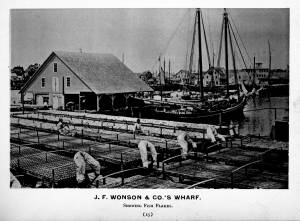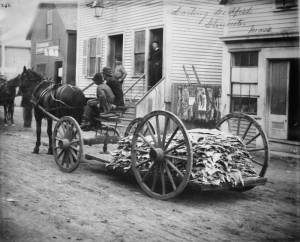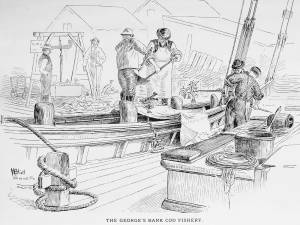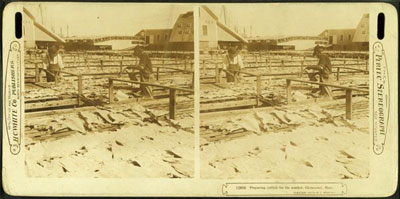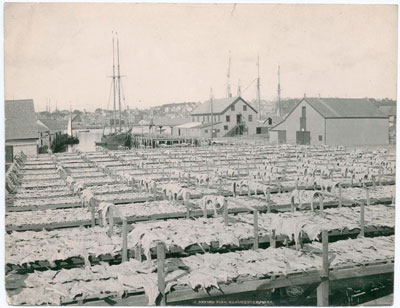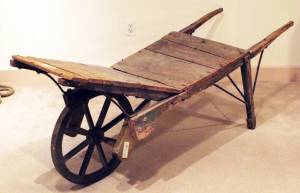An online project under the direction of the CAPE ANN MUSEUM
Historical Materials: Maritime & Other Industries & Facilities
Historical Materials » Maritime & Other Industries & Facilities » Drying Fish
Drying Fish
View related Fitz Henry Lane catalog entries (7) »
The processing of dried salt cod (the most common form of salt fish) began after the hooked cod came on board and was put in a holding pen on deck until there was a large deck load or the day's fishing was done. At that time, the fish would be split, gutted (the livers were saved, the head removed, and the tongues and cheeks cut out). The split fish were placed in pens in the hold, carefully salted as they were stacked in layers. This initial salting kept them in good condition until they were landed at the fish pier.
After landing, each fish was carefully washed in a dory filled with sea water, removing much of the initial salting. They were then given a second salting, using a finer grade with fewer impurities. Then they were loaded onto a barrow or cart, and wheeled to the flake yard, where they were spread out on wooden racks, called "fish flakes," to dry. Drying time could take days, depending on weather and temperature. Warm, sunny weather could speed up the drying time, but also "burn" the fish, spoiling its texture and flavor. To prevent this, canvas awnings were stretched over wooden frames built onto the flakes.
Rain was also harmful to the fish, which were gathered in compact piles on the flakes and covered with up-turned wooden boxes until dry weather returned. Once dried, the fish were returned to the fish house and stored in a dry room, awaiting skinning, trimming, and packaging for the domestic market.
– Erik Ronnberg
Related tables: Bird Hunting » // Flake Yard »
c.1900.
Also filed under: Flake Yard »
Cape Ann Museum Library & Archive
Also filed under: Cod / Cod Fishing » // Flake Yard » // Historic Photographs »
Wood drying racks, metal split salt fish. Scale: ½" = 1' (1:24)
Original diorama components made, 1892; replacements made 1993.
Cape Ann Museum, from Gloucester Chamber of Commerce, 1925 (2014.071)
Fish flakes are wood drying racks for salt codfish, and have been used for this purpose in America since colonial times.
Also filed under: Flake Yard »
In G. Brown Goode, The Fisheries and Fishery Industries of the United States (Washington, DC: Government Printing Office)
A vessel having returned from the fishing grounds with a fare of split salted cod, is discharging it at a fish pier for re-salting and drying. The fish are tossed from deck to wharf with sharp two-pronged gaffs, and from there to a large scale for weighing. From there, they will be taken to another part of the wharf for washing and re-salting.
– Erik Ronnberg
Also filed under: Cod / Cod Fishing » // Fishing » // Georges Bank, Mass. »
New York Public Library
Also filed under: Cod / Cod Fishing »
In G. Brown Goode The Fisheries and Fishery Industries of the United States (Washington, DC: Government Printing Office)
See pl. 35.
After landing and weighing, the cod are split and washed, a dory filled with water serving as the wash tub. Once thoroughly rinsed of the coarse first salting, the split cod are piled in the wharf shed where they will be re-salted, usually with a finer grade of salt, and stored in bins or large casks until ready for drying on the fish flakes.
– Erik Ronnberg
Also filed under: Cod / Cod Fishing »
Also filed under: Fishing »
5' 11" l. x 28" h. x 23" w. Wheel 20" d.
19th–early 20th century
Cape Ann Museum. Gift of the Gloucester Fishermen's Museum (2542)
Used to move salt fish in a flake yard. Barrows of this type were commonly used to carry a wide variety of materials around the waterfront.
View related Fitz Henry Lane catalog entries (1) »
Also filed under: Objects »
